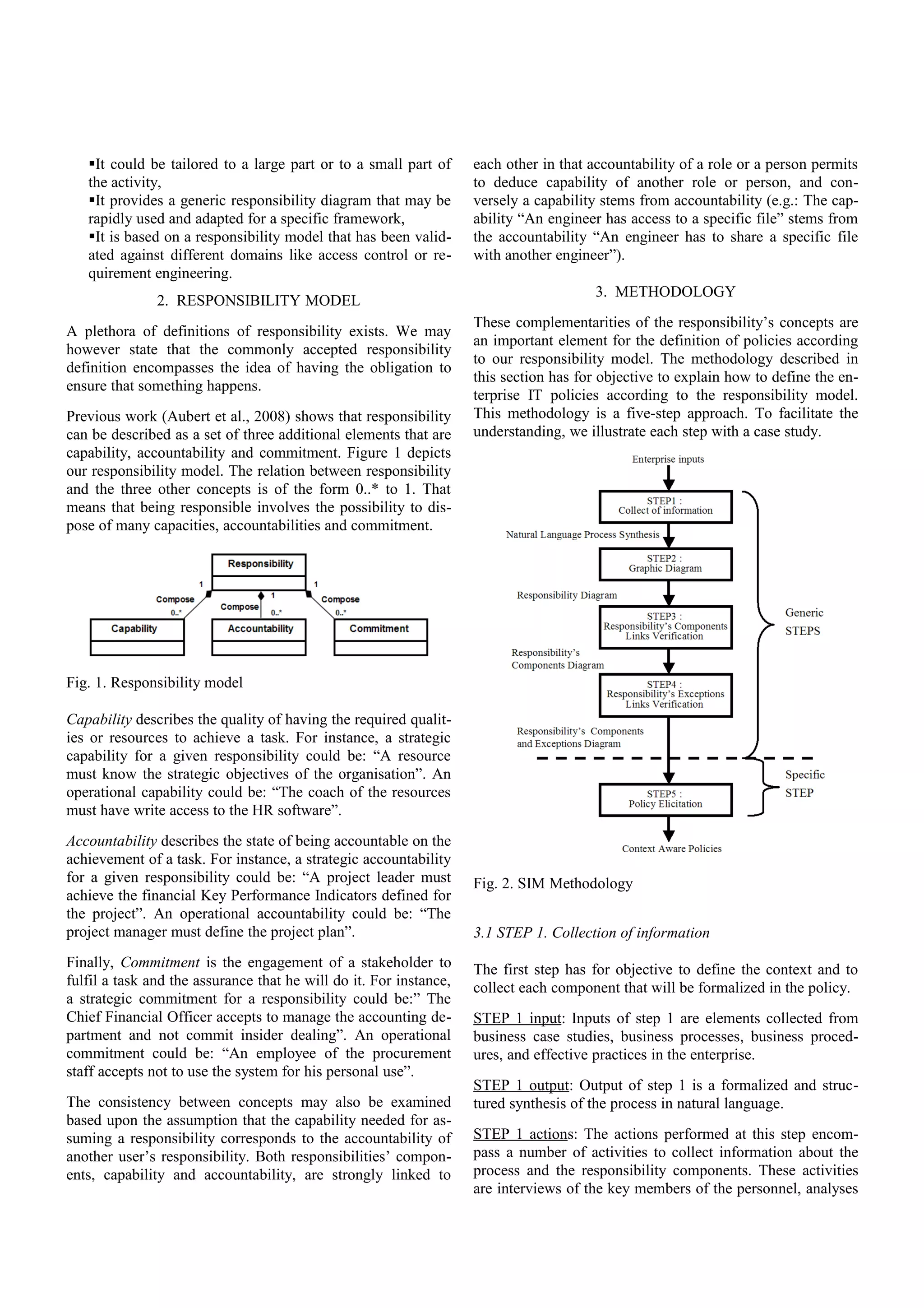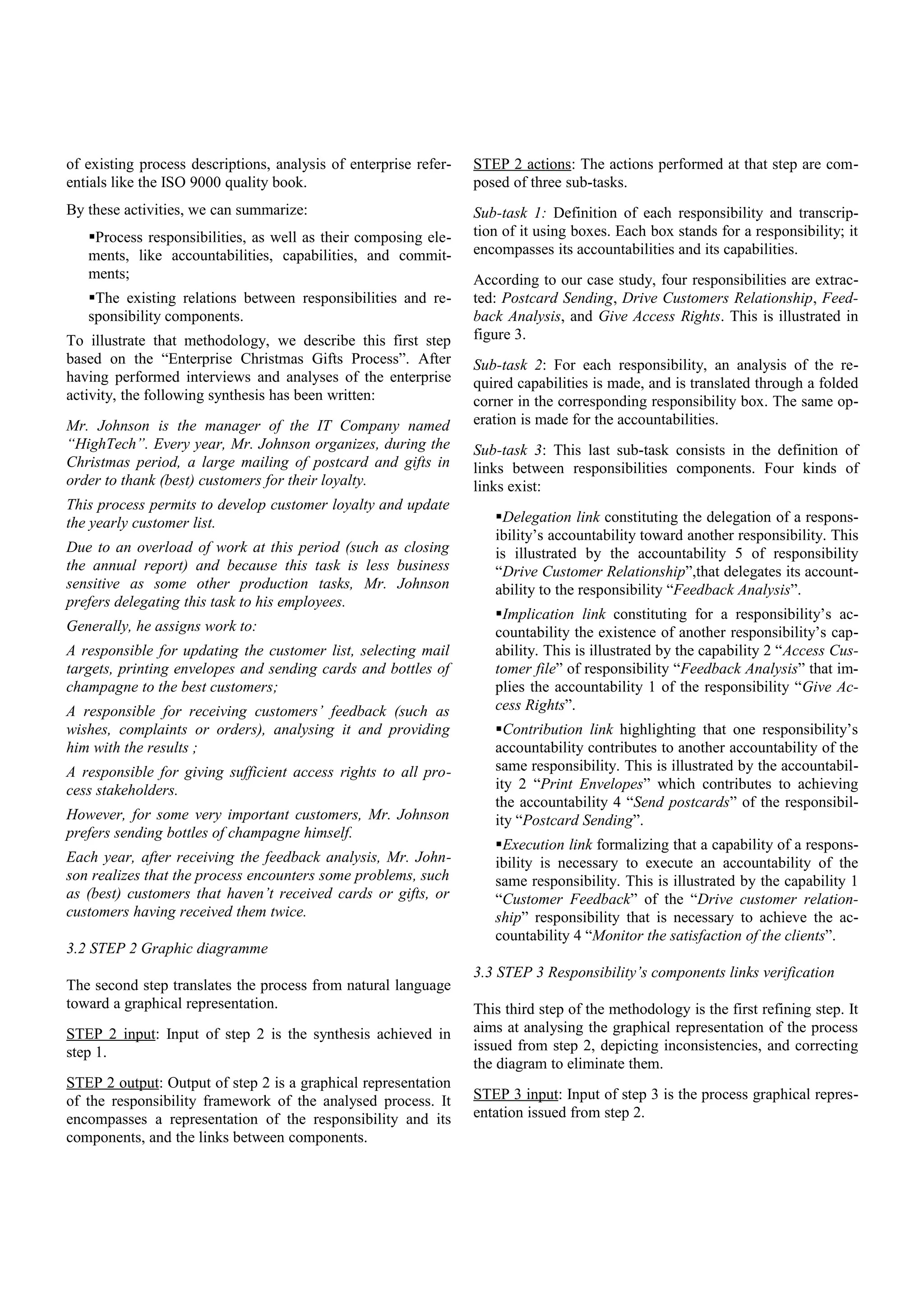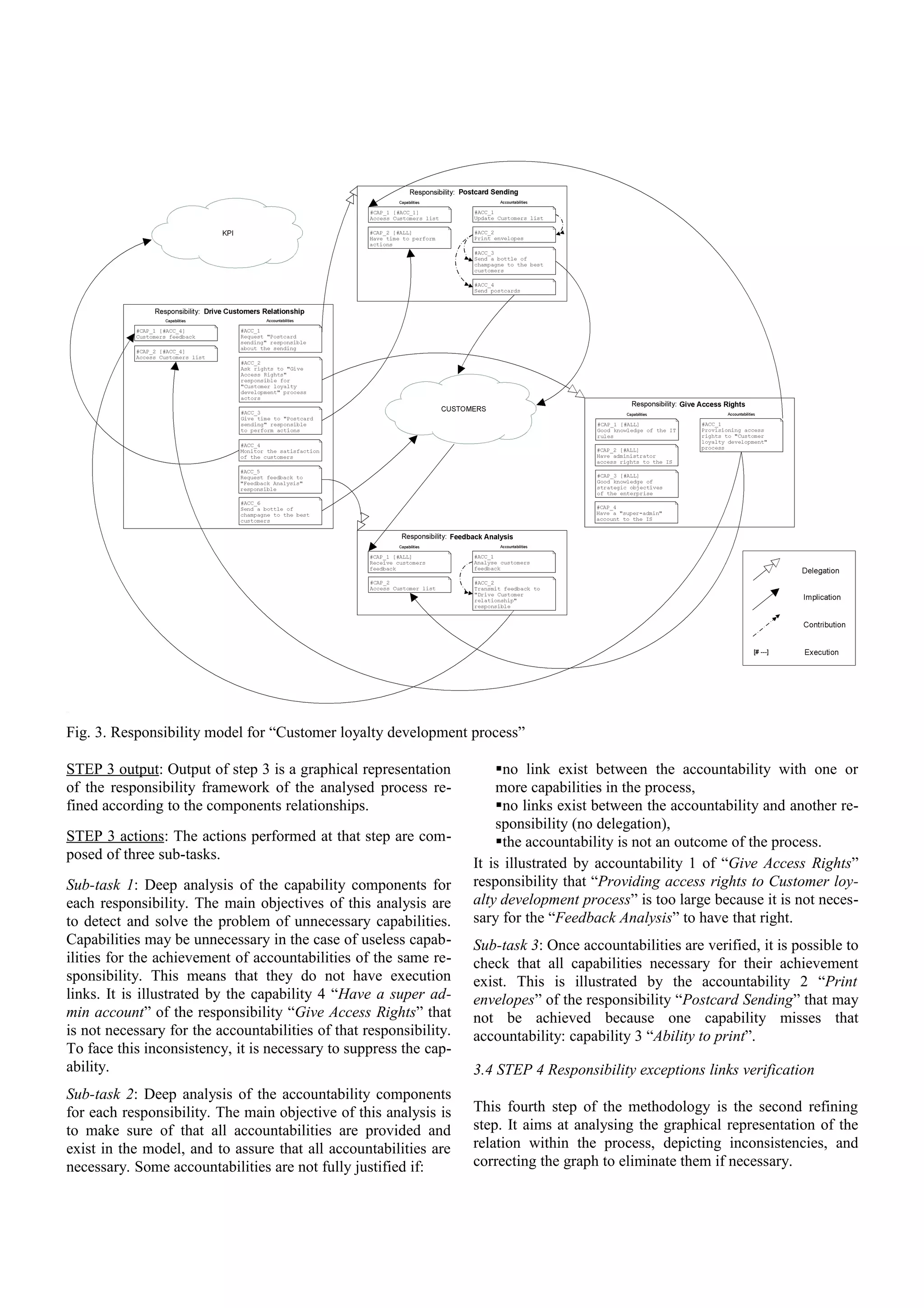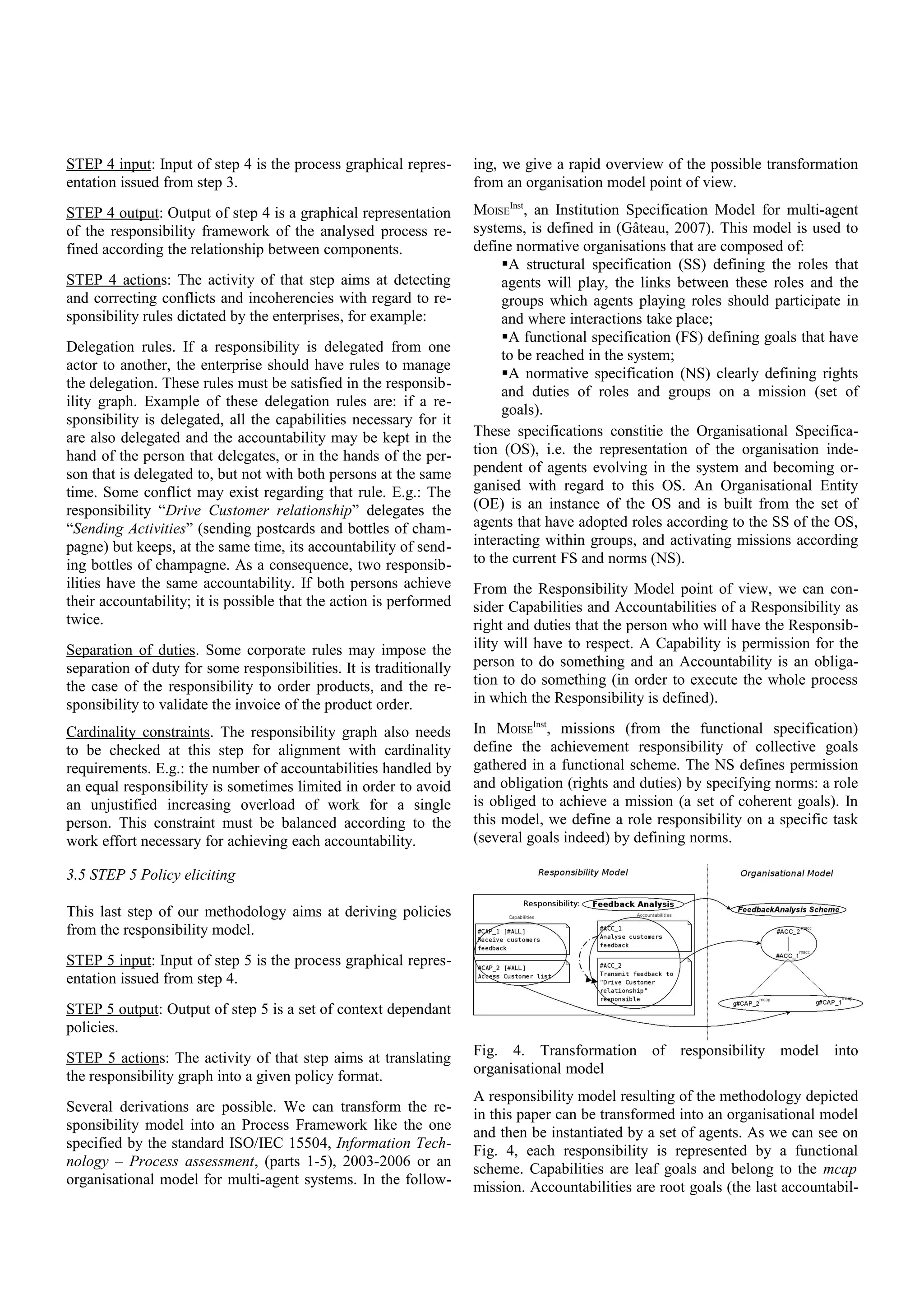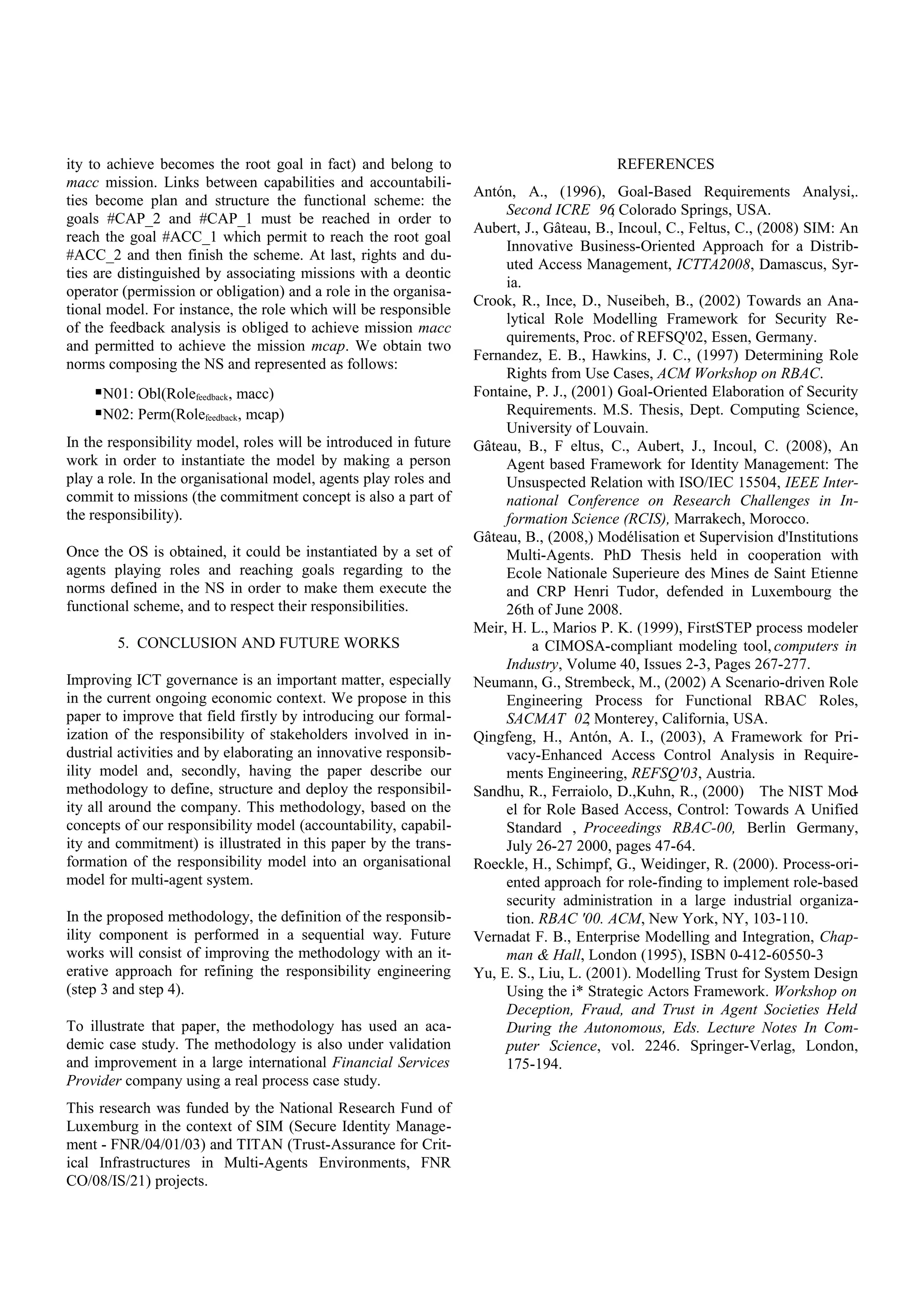The document presents a methodology named SIM, designed to align business and IT policies by defining clear responsibilities based on the concepts of capability, accountability, and commitment. It emphasizes the importance of governance in IT, particularly following financial scandals, and proposes a five-step process for establishing responsibility in organizational contexts. The methodology is illustrated through case studies and aims to fill gaps in existing frameworks by integrating responsibility into IT policy development.
![Who Govern my Responsibilities?
SIM: a Methodology to Align Business and IT Policies
in the Industrial Field.
Christophe Feltus, Christophe Incoul, Jocelyn Aubert, Benjamin Gâteau
Public Research Centre Henri Tudor, 29, Avenue John F.Kennedy,
L-1855 Luxembourg-Kirchberg, Luxembourg
(e-mail: christophe.feltus@tudor.lu)
Abstract: Governance of IT is becoming more and more necessary in the current financial economic
situation. This trend does not avoid the definition of corporate and IT policies. To improve that matter,
the paper has for objective to propose a methodology for defining policies that are closer to the business
process, and based on the strict definition of the actors’ responsibility. This responsibility model is
mainly defined based on the three concepts of capability, accountability and commitment. The methodo-
logy is illustrated based on a case study that highlights how it is possible to implement access control
mechanism through agent-based infrastructure by extracting requirements from company practices and
process formalizations.
Keywords: Models, Responsibility, Process Model, IT Policies, Agent Framework, ICT Governance.
1. INTRODUCTION
The importance of the Governance of ICT is becoming more
and more important in companies, particularly since the ac-
counting scandals of 2002, and more currently through the
ongoing market crisis. The case of Enron is one famous and
well-known example. Following those scandals, a lot of laws
and standards were published in order firstly to guarantee the
stability of the financial sector and, by extension, all sectors
of the industrial economy, and secondly, to enhance the gov-
ernance of all these public and private companies. Sarbanes-
Oxley is one of these laws that aim at providing guarantees
over the company’s accountability. The new ISO/IEC
38500:2008 Corporate governance of information techno-
logy standard is one standard that provides a framework for
effective governance of IT. One of the main constraints im-
posed by these laws and standards is to have responsibilities
clearly established and accepted internally by the collaborat-
ors and externally by the stakeholders as well. The import-
ance of that statement has oriented our works and we pro-
pose, in the scope of that research, to make a contribution to
one of the most significant pillars of the governance, which is
responsibility. This concept has a major meaning in the ma-
nagerial pyramid of the company in that it composes the
structural artefact of the decisional framework. Con-
sequently, it sounds justified to guarantee accurate decisions
to ensure that responsibilities of enterprise activities are
rightly defined and enforced. It implies that having respons-
ibility appropriately affected involves a prior clear definition
of its components (capability, accountability and commit-
ment), and to develop an efficient methodology to analyse
and fix them through all the decisional layers of the com-
pany, from the top layer down to the technical one. The first
part of that twofold objective has already been basically in-
vestigated in our previous work (Gâteau et al., 2008). Indeed,
by depicting how the responsibility is introduced and inter-
preted in a large number of industrial frameworks, we have
been able firstly to extract main components of it and,
secondly, to validate them through a responsibility ontology.
This ontology has been built by analyzing how responsibility
components are declined in the realm of IT security, from ac-
cess control models such as RBAC (Sandhu et al., 2000) up
to framework for ICT governance like Cobit [4], in the realm
of requirement engineering, as well as through EAM frame-
works like CIMOSA (http://www.cimosa.de/) or PERA
(http://www.pera.net). The issue of that wide review of struc-
turing framework has lead to the conclusion that mainly three
components build the responsibility concept. Those compon-
ents are: capability, accountability and commitment. The
second part of the research aims at elaborating a methodo-
logy for defining, structuring and deploying the responsibil-
ity in industries’ information systems. In the literature, each
area of information activity already has methods for elaborat-
ing its information frameworks. In the field of requirement
engineering: (Yu et al., 2001), (Antón, 1996) and (Fontaine
et al., 2001), in the field of access control: (Fernandez, 1997)
(Roeckle et al., 2000) (Crook et al., 2002) (Qingfeng et al.,
2003) (Neumann et al., 2002), and in the field of EAM: (Ver-
nadat, 1995) (Meir, 1999). However, none of them integrate
the notion of responsibility in their methodology. Our work
aims at filling that gap with an innovative five-step method
focusing on the responsibility ontology. The advantage of
this method will be:
It is focused on the concept of responsibility rather than
on a concept of role, user, or activity,
It is adapted to manage responsibility exceptions.](https://image.slidesharecdn.com/whogovernmyresponsibilitiessimamethodologytoalignbusinessanditpoliciesintheindustrialfield-141222065505-conversion-gate02/75/Who-govern-my-responsibilities-sim-a-methodology-to-align-business-and-it-policies-in-the-industrial-field-1-2048.jpg)
